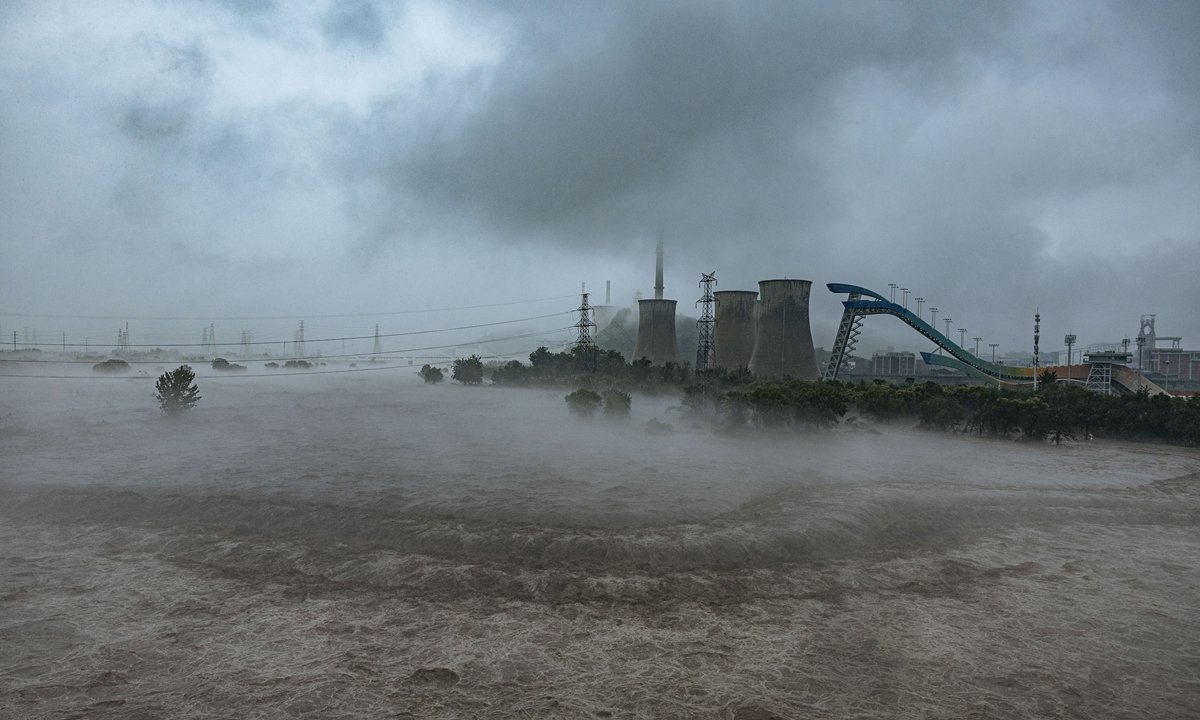Torrential rain has been relentlessly pounding the Chinese capital and northern China for four consecutive days, resulting in widespread flooding and the tragic loss of at least 20 lives. The region has been under siege by severe rainstorms, remnants of Typhoon Doksuri, since Saturday. In response to the crisis, Chinese authorities have launched massive rescue and relief operations.
As of Tuesday afternoon, Beijing authorities reported 11 fatalities due to the rainstorms in the city, including two selfless rescuers who sacrificed their lives while on duty. The worst affected districts include Mentougou and Fangshan, which have witnessed four and two fatalities, respectively. Additionally, Changping district and Haidian district reported four and one deaths, respectively. The neighboring Hebei province also suffered heavy casualties, with nine people losing their lives in the ongoing downpours. Baoding City and Xingtai City in Hebei were the hardest hit, accounting for four and five deaths, respectively. As of the latest update, 19 people are still missing in Beijing and Hebei.
Reacting promptly to the disaster, Chinese President Xi Jinping has issued a directive demanding a comprehensive search and rescue effort for those missing or trapped by the floods and geological disasters. He emphasized the importance of providing medical treatment to the injured and extending aid and comfort to the families of the deceased. President Xi stressed that utmost efforts should be made to ensure the safety of lives, properties, and social stability.
In response to the calamity, China has allocated 110 million yuan ($15.43 million) to support flood prevention and disaster relief work in Beijing, Tianjin, and Hebei. The funds will be utilized to facilitate emergency rescue operations and provide relief to the flood-affected populace.
The situation in North China is dire, with record-breaking rainfall recorded. As of 6 am on Tuesday, Beijing experienced an average precipitation of 257.9 mm, while Mentougou and Fangshan districts were inundated with 470.2 mm and 414.6 mm of rainfall, respectively. As a result, around 45,000 individuals in 13 districts of the capital have been severely affected, and 127,000 people have been evacuated. The economic losses are still being calculated by municipal authorities.
Comparisons indicate that the current rainfall intensity has far exceeded that of the devastating incident on July 21, 2012, which claimed 79 lives across Beijing, half of them in Fangshan district. The recent peak rainfall even surpassed the 2012 record, with over 700 mm of rainfall recorded at two weather stations.
In response to the escalating disaster, Beijing has intensified relief efforts, utilizing People’s Liberation Army helicopters to airdrop essential supplies and evacuate stranded residents.
Water resource departments in Beijing, Tianjin, and Hebei have come together to tackle the flooding situation by implementing effective flood control measures. These efforts include pre-discharging floodwaters and coordinating upstream and downstream actions to minimize the overall impact of the flooding in the region.
In a significant move, Beijing used the Beijing Zhaitang Reservoir for the first time since its construction in 1998 to pre-discharge floodwaters on Sunday. Subsequently, runoff was diverted to the reservoir on Monday, resulting in effective flood control measures. The Huairou Reservoir also joined in flood discharge efforts on Tuesday afternoon, with its maximum downward flow surpassing previous years’ average amounts by over four times.
Amid the disaster, the Beijing Blue Sky Rescue Team, a Chinese civil rescue squad, has been instrumental in saving lives. The team deployed 563 rescuers and 263 vehicles for rescue missions in Beijing. They successfully transferred more than 1,680 stranded individuals and 22 trapped vehicles while rescuing over 210 endangered people in Fangshan and Mentougou Districts. However, rescue operations were met with various challenges, including adverse weather conditions, insufficient rescue supplies, and physical exhaustion.
Affected communities in the region have also mobilized to help each other. Villagers in Mentougou and other areas organized mass evacuations and spontaneous rescue efforts. Despite their best efforts, the floods still caused severe damage to villages, with many houses being washed away, roads being cut off, and power outages affecting several regions.
Hebei Province experienced intense rainfall, with more than 400 million cubic meters of water pouring into its waterways over three days. This resulted in significant rises in water levels at 142 stations on major rivers. The province activated seven flood storage areas and successfully transferred 847,400 people to safety.
Cities like Zhuozhou and Xingtai in Hebei bore the brunt of heavy rain. Zhuozhou suffered blackouts and water supply disruptions, affecting more than 130,000 people and relocating 83,100 individuals. The Blue Sky Rescue Team received numerous appeals for help, highlighting the dire situation in the area.
Weather forecasts indicate that the rain in Beijing, Tianjin, and Hebei is expected to weaken from 8 am Tuesday to 8 am Wednesday. However, certain regions may still experience moderate to heavy rainfall, particularly in western-central and northern Hebei, Beijing, northern Tianjin, and northern and western Henan Province, with the possibility of short bursts of heavy precipitation.
The authorities have issued warnings regarding potential secondary disasters, such as small and medium-sized river floods, flash floods, and geological disasters, which may occur due to heavy precipitation in mountainous areas.
The unprecedented and prolonged rainfall in the region has surpassed expectations, causing severe flash floods and mudslides. Despite the challenges, Beijing’s timely forecasts and warnings, as well as measures to halt non-essential activities and close tourist attractions, have effectively prevented further casualties and mitigated the impact of the disaster.
Read More:
